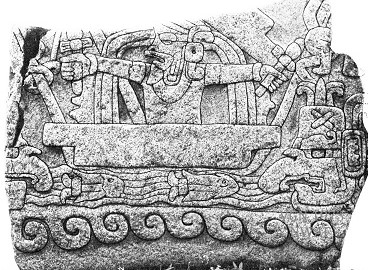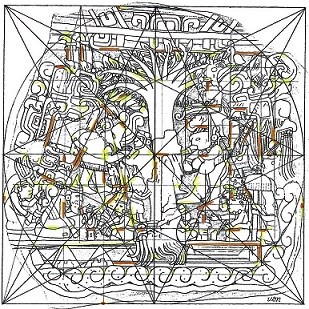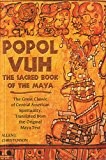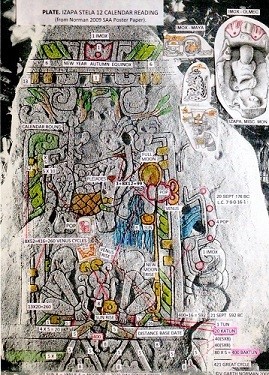Discovery
50 years of Izapa exploration at the Preclassic Izapa, Mexico’s Temple Observatory at 15 degrees North Latitude = Birthplace of the Maya 260-day Calendar.
Calendar research of ancient hieroglyphic writing in Mesoamerica includes Garth Norman’s Astronomical Orientations of Izapa Sculptures (1980) and his recent Izapa Sacred Space: Sculpture Calendar Codex (2015-English; 2016-Espanol).
- CALENDAR research by Garth Norman (1965-2020) is a major key to decoding the Preclassic history of Izapa (ca. 500 BC to 200 AD). Izapa’s plazas, carved stone monuments, & pyramids were oriented to cycles of the sun, moon, Venus, & constellations.

- Explore the founding of Izapa by highly educated, BEARDED MIGRANTS ON THE SEA in the 5th century BC. that merged with Izapa’s surviving Olmec peoples (1500 BC–500 BC) to build a sophisticated temple center, equal to Teotihuacan (1 AD). BELOW: IZAPA STELA 67 = Bearded man in boat.

- Ancient Izapan building tools were from the eastern Mediterranean world, including astronomy, calendars,GEOMETRY & STANDARD MEASUREMENTS. Below: a. BABYLONIAN & EGYPTIAN CUBITS BUILT art & architecture at Izapa.
 b. Izapa Stela 5 Tree of Life Monument showing Middle East GEOMETRY.
b. Izapa Stela 5 Tree of Life Monument showing Middle East GEOMETRY.
- Izapa (500 BCE) is the ancestor of picto-graphic writing in Maya & Mixtec codices a 1,000 years later. Izapa’s POPOL VUH first ancestors came from across the sea (Stela 67 = #2 above).

- Izapa’s sophisticated calendar records world history & prophecy from creation to the afterlife. Carvings on Izapa Stela 12 (below) show 592 BC dates, also evident on Stela 5 with the “great year” of the Maya five world ages.

- Izapa’s temple archive could become the first major achievement of the ultimate goal of archaeology, according to the late leading New World anthropologist Gordon R. Willey of Harvard University: “to discover the ideologies of lost civilizations and be able to assess their effectiveness to a greater or lesser degree for ensuring political and social success.”
Can a deeper understanding of the Preclassic history evident at Izapa and its cultural heritage that spread to all of Mesoamerica be evaluated for application to modern political and social challenges?
Izapa gained worldwide notoriety at the “end” of Maya five world ages on December 21, 2012. Traditional Highland Maya “Day-Keeper” Elders went to IZAPA on Dec.21,2012 to perform a sunrise fire ceremony to usher in the new 13 Baktun Age. K’iche’ migration creation celebration in the POPOL VUH when the Maya ancestors arrived in Guatemala in darkness and climbed a mountain to await the first appearance of Venus to usher in the first sun of the creation of a new age. View an important Maya fire ceremony at Izapa on YouTube: http://youtu.be/VovXbt14Eso & on http://izapacalendar.com.
BOOK REVIEWS
of V. Garth Norman’s Izapa Sacred Space: Sculpture Calendar Codex (2015-English; 2016-Espanol)
Dr. Allen J. Christenson, Author-Translator of the Popol Vuh, Literal Poetic Version 2004.
“Garth Norman’s discovery of a massive calendar observatory system with astronomical alignments of mounds and monuments convincingly demonstrates that the Izapa monuments must be studied and interpreted as a whole, rather than try to read them individually or out of context. In addition, he masterfully demonstrates that Izapan artistic symbolism is just as highly developed a system of communication as the later hieroglyphic texts of the Maya, and a precursor to their development. Norman’s profound understanding of the underlying Mesoamerican theology of Izapa and related cultures uses the myth narratives of the Popol Vuh, sacred book of the K’iche’ Maya, and ethnographic sources creatively, showing that the Izapans were not just interested in the dance of planets and stars in the heavens, but also in what these movements say about the cycles of life itself. This book will surely prove to be of great interest to anyone interested in the art, science, and culture of ancient Mesoamerica.”
Dr. Scott Olsen, Professor of Philosophy, College of Central Florida; author of The Golden Section, Nature’s Greatest Secrets, 2006.
“Careful research and observations at the Izapa temple site, combined with some of the most comprehensive knowledge of ancient Olmec-Izapan-Maya calendar systems is contained in V. Garth Norman’s latest book, Izapa Sacred Space. Norman’s stunning discoveries of geometric design planning, and standard measures in monuments and architecture, as well as the 260-day sacred Maya calendar at Izapa attest to the astonishing knowledge gathered by the priest-astronomers at Izapa.”
Dr. Jason Jones (University of Warwick, England)
In 2012 Dr. Jones conducted RTI (Reflectance Transformation Imaging) digital technology recovery that confirmed the accuracy and integrity of Norman’s NWAF sculpture project (1973, 1976), questioned by flawed artistic re-drawings in the late 1990’s. Also in 2012, Dr. Robert M. Rosenswig (University of Albany), confirmed the accuracy of NWAF’s Izapa topo site map with LIDAR mapping. These studies back Izapa’s Precession measures site layout, and Stela 5’s World Tree time scale and geometric site map discovered by Norman.